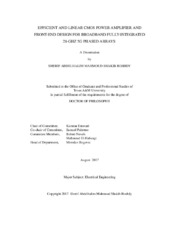| dc.description.abstract | Demand for data traffic on mobile networks is growing exponentially with time and on a global scale. The emerging fifth-generation (5G) wireless standard is being developed with millimeter-wave (mm-Wave) links as a key technological enabler to address this growth by a 2020 time frame. The wireless industry is currently racing to deploy mm-Wave mobile services, especially in the 28-GHz band. Previous widely-held perceptions of fundamental propagation limitations were overcome using phased arrays. Equally important for success of 5G is the development of low-power, broadband user equipment (UE) radios in commercial-grade technologies. This dissertation demonstrates design methodologies and circuit techniques to tackle the critical challenge of key phased array front-end circuits in low-cost complementary metal oxide semiconductor (CMOS) technology. Two power amplifier (PA) proof-of-concept prototypes are implemented in deeply scaled 28- nm and 40-nm CMOS processes, demonstrating state-of-the-art linearity and efficiency for extremely broadband communication signals. Subsequently, the 40 nm PA design is successfully embedded into a low-power fully-integrated transmit-receive front-end module.
The 28 nm PA prototype in this dissertation is the first reported linear, bulk CMOS PA targeting low-power 5G mobile UE integrated phased array transceivers. An optimization methodology is presented to maximizing power added efficiency (PAE) in the PA output stage at a desired error vector magnitude (EVM) and range to address challenging 5G uplink requirements. Then, a source degeneration inductor in the optimized output stage is shown to further enable its embedding into a two-stage transformer-coupled PA. The inductor helps by broadening inter-stage impedance matching bandwidth, and helping to reduce distortion. Designed and fabricated in 1P7M 28 nm bulk CMOS and using a 1 V supply, the PA achieves +4.2 dBm/9% measured Pout/PAE at −25 dBc EVM for a 250 MHz-wide, 64-QAM orthogonal frequency division multiplexing (OFDM) signal with 9.6 dB peak-to-average power ratio (PAPR). The PA also achieves 35.5%/10% PAE for continuous wave signals at saturation/9.6dB back-off from saturation. To the best of the author’s knowledge, these are the highest measured PAE values among published K- and K a-band CMOS PAs to date.
To drastically extend the communication bandwidth in 28 GHz-band UE devices, and to explore the potential of CMOS technology for more demanding access point (AP) devices, the second PA is demonstrated in a 40 nm process. This design supports a signal radio frequency bandwidth (RFBW) >3× the state-of-the-art without degrading output power (i.e. range), PAE (i.e. battery life), or EVM (i.e. amplifier fidelity). The three-stage PA uses higher-order, dual-resonance transformer matching networks with bandwidths optimized for wideband linearity. Digital gain control of 9 dB range is integrated for phased array operation. The gain control is a needed functionality, but it is largely absent from reported high-performance mm-Wave PAs in the literature. The PA is fabricated in a 1P6M 40 nm CMOS LP technology with 1.1 V supply, and achieves Pout/PAE of +6.7 dBm/11% for an 8×100 MHz carrier aggregation 64-QAM OFDM signal with 9.7 dB PAPR. This PA therefore is the first to demonstrate the viability of CMOS technology to address even the very challenging 5G AP/downlink signal bandwidth requirement.
Finally, leveraging the developed PA design methodologies and circuits, a low power transmit-receive phased array front-end module is fully integrated in 40 nm technology. In transmit-mode, the front-end maintains the excellent performance of the 40 nm PA: achieving +5.5 dBm/9% for the same 8×100 MHz carrier aggregation signal above. In receive-mode, a 5.5 dB noise figure (NF) and a minimum third-order input intercept point (IIP₃) of −13 dBm are achieved. The performance of the implemented CMOS frontend is comparable to state-of-the-art publications and commercial products that were very recently developed in silicon germanium (SiGe) technologies for 5G communication. | en |


